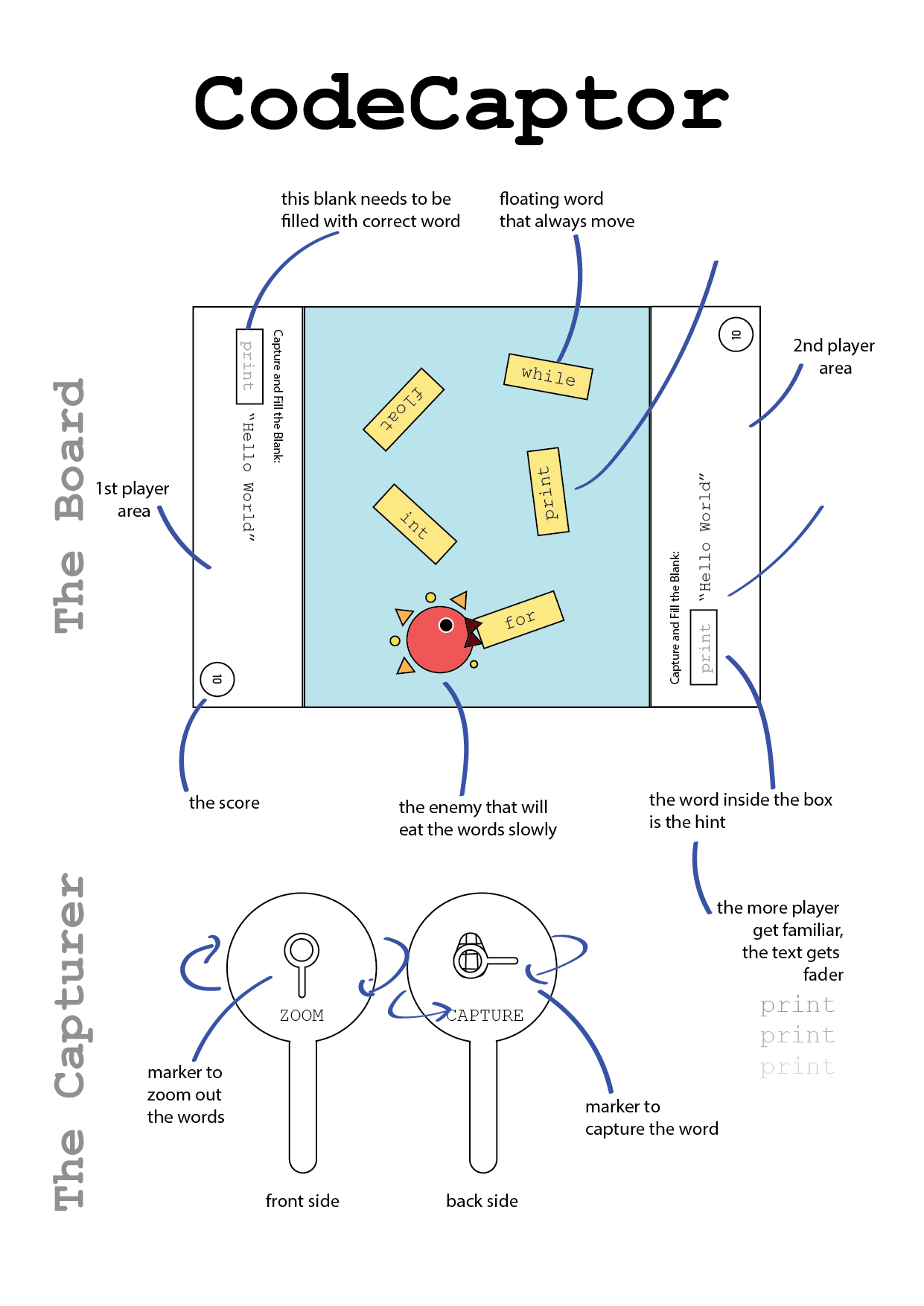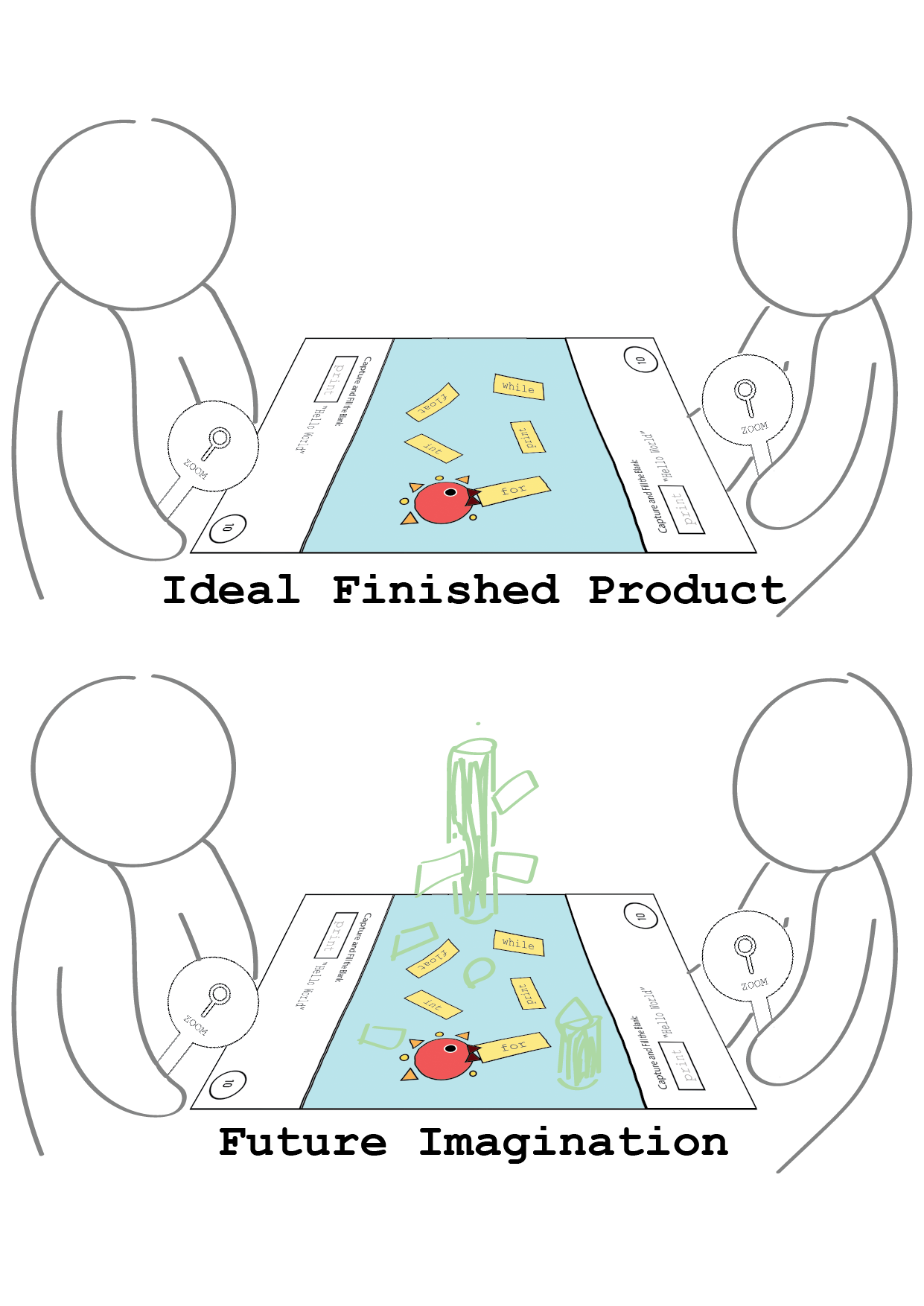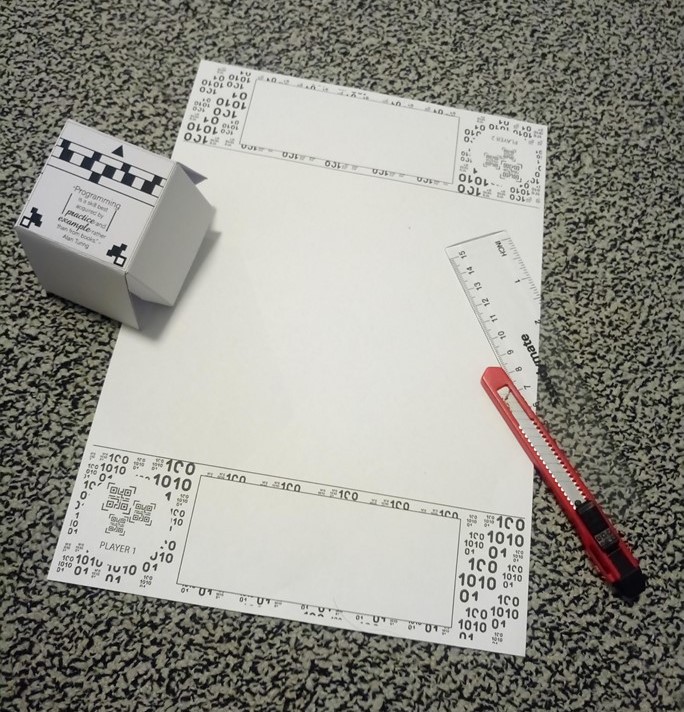Sky Reacher
Bee Bear Lions
Ninja! Run!
CodeCaptor
Prototype
Final Form
Exhibition
CodeCaptor doesn't come just like that. Initially, other ideas were no less grand but needed further development and consideration. CodeCaptor originated from Sky Reacher who appeared at the beginning of this semester in the same course.
Do you know? Sky Reacher uses the projected Augmented Reality concept. So the virtual image that you usually see on the monitor or smartphone screen can be viewed directly on the physical object in front of you. This idea is intended for children to learn problem-solving. Goals and challenges complement this activity. The goal that players need to achieve is to arrange each block so the virtual character can reach the sky. Also, there is a challenge, a block containing a ball that can vibrate all the blocks that are arranged. Be careful because everything you make can be in vain. Therefore, move fast! And don't forget to have fun!
By using World Café activities, Sky Reacher is included in the Creative Learning category. This categorization is made based on our ideas that determine who will be the same team. I indeed focus on the group where my idea is, although I know that the concept will not necessarily be used.
After going through several stages of the World Cafe and voting on the category that we like, finally, the BBL (Bee Bear Lions) Team is formed, consisting of me, Wentai Ouyang, Bowen Jiang, and Sulaiman Ma. In the early weeks, we still often met in class and in meetings that we had agreed together. However, because of the current pandemic, we can only meet via Zoom until the last week of lectures. Also, we decided to work on this course project separately. To find out about the project planned by BBL, please see the next process, Ninja Run!
BBL decided to focus on the Creative Learning category to teach something in a fun way. From all the team members, some topics were proposed to be taught, including electrical devices, alchemy, programming, and others. I have already produced several ideas on different topics. However, according to the agreement, we decided to teach programming.
Of all the topics in the world, why did we choose programming? The answer is because programming is a skill that parents want for their children. Technology is increasingly sophisticated. The role of the programmer is expected to open up employment opportunities by 1.3 billion in 20221. Therefore, programming has been taught from an early age and even become subjects in schools in several countries, including Australia. Unfortunately, programming is less attractive to students because it is difficult to understand2.
BBL took a role to make a product to teach children or anyone who wants to learn to program. We provide solutions in the form of games because games can be inserted by learning topic and are able to make children feel happy. If both are obtained, then programming will motivate them to become future programmers.
Ninja! Run! is the predecessor of CodeCaptor. This game is a board game inspired by 7 Billion Humans and Square Off NEO & SWAP (Board Games Powered by Robotics & AI). This game is targeted at children aged 9-11 years, people who interest in coding, and physical gamers. This game is planned to be played by more than two people. But for this project, we limit the players to just two people. Two players will compete quickly to move the real character on the board (shaped maze). To move the object, players must complete a series of commands such as move front, left, and right, so that only the robot's hand under the board will move the real character. Controls are made in the form of blocks that will be read using a camera, such as the AR concept. Players must explore the existing maze and make a series of problem-solving to complete. Simple language and less complicated problems are our targets to give to children.
1Alsubaie, A., Alaithan, M., Boubaid, M., & Zaman, N. (2018). Making learning fun: Educational concepts & logics through game. In (Vol. 2018-, pp. 454-459): Institute of Electrical and Electronics Engineers Inc.
2Assathiany, R., Guery, E., Caron, F. M., Cheymol, J., Picherot, G., Foucaud, P., & Gelbert, N. (2018). Children and Screens: A Survey by French Pediatricians. Archives de pédiatrie, 25(2), 84-88. doi:10.1016/j.arcped.2017.11.001
Finally, here we come to the birth of CodeCaptor. So, after we explored various game examples to learn to program, we found that existing products taught in the same way, namely by using simple methods, such as simple words, and simple techniques. Another example that we found was LoCoMoGo. Although there is an element of real coding, for younger children, it is enough to use tape with different variations as a command for train toys.
We are doing presentations for Ninja! Run, and we get some feedback from classmates. One of them became my main focus, namely the gap between learning coding with actual coding. Even though players are good at playing coding games, they will experience difficulties when dealing directly with codings in the real world, such as C, Java, PHP, and others. BBL changed the concept of the game Ninja! Run into several other solutions by focusing on the topic being taught. Questions that emerged on this team were actual coding, robot coding, and pseudocode algorithm. Following the mutual agreement, we split with each other's solutions. I focus on the pseudocode algorithm.
Pseudocode is an algorithm that is taught before a student enters into real coding learning. The language used in English and its structure is similar to actual coding in general. This is where CodeCaptor was born to bridge learning with real practice. For the form of the game, I refer to my initial idea, Sky Reacher.
The initial concept of CodeCaptor was projected AR Game. This game will be projected on the board marker. Questions and answer options will be displayed in this board. Every players have their capturer. They will capture the virtual object using the physical object.


Prototype is the stage where I start the production stage. The main function of the CodeCaptor prototype that must be achieved at this stage is retrieving virtual objects using physical objects. I use Unity and Vuforia. Because I don't have a background on AR, I first learned about it this semester. I use a tutorial on YouTube. Many tutorials that provide basic knowledge for AR. One of them is Playful Technology. However, I found it difficult to find a suitable tutorial for the main functions of the prototype that I will make. Until I finally found a tutorial by 3dJeebs.
The main thing that is most challenging in making AR games is making good quality markers. I designed markers for this game many times until I found five-star markers according to Vuforia's rate. Markers with more details are more likely to have a rate of five. In addition, markers that have a lot of empty space will have much smaller stars in Vuforia.
This prototype has been made with several evaluations that I made myself. I find that virtual levels are different from levels in the real world. Markers close together may not be at the same level. So it will be difficult to collide between objects from two different markers. In addition, this level problem makes virtual objects can not be seen as one. Our hands will always be under the virtual object, even if the hand is above the marker. I also get some feedback obtained from classmates, such as the target audience that needs to be made more specific, the addition of features, and the addition of material to be more complex. All feedback is planned to be made in the form of final delivery.

After the prototype, I tested the AR Game into the projector. But I got several problems. I need the camera to read the markers, and the projector needs the darkness to work powerful. In the dark, the camera cannot read the markers at all. So, I changed the concept. I don't use the projector to display the game. I was focused on finding an alternative solution. I interviewed an ex-teacher after the prototype delivery. Based on the interviewee's experience, I found out that children are full of curiosity. They like the device that can be used to see the unseen objects. So, I changed the shape of the capturer into the form that you can find on the first page of this website.

In the final form, I changed the shape of markers too. I turned the capturer marker into the smartphone. Players should see the virtual object through this capturer. Small screen smartphone is better because it will give the feeling of being a detective or explorer. Meanwhile, I broke the board marker. I made this with the purpose of this game being played by more than two people. Also, I added the answer markers to avoid the layer of the virtual object. If players can touch the answer markers, it would give them the feeling of moving the virtual object.
I redesigned every marker that I had. I found a helpful website that can generate the marker for AR. The website is called Brosvision. I took the image from that website, and then I put it in the template of the box. I chose the box shape so players can hold it comfortably. I used the model from TemplateMaker.nl. The markers were made of paper. There was space inside the box, so I need to handle it with care. In the future, it is better to use more durable material like wood.
Everything that has been done in this course is documented in the journal.
The exhibition was held on June 10, 2020. Due to the pandemic, the show was conducted online using this website and Discord for discussions and live product demonstrations from each team. Although some students came to campus to do it, most students were at home each. The exhibition will be held in only three hours. The time given is not enough to explore all groups, mostly in one group; there are several different solutions.
I conclude two significant problems that occurred in this exhibition and hope for a better future. The first is internet problems. Australia is very good with adequate internet quality, although in some places it does not get a large quota. However, this is a big problem for a country like Indonesia. I invited friends in Indonesia because this was an excellent opportunity to see exhibitions that generally cannot be viewed online. However, due to poor internet quality, live streaming is difficult for them to enjoy there. Hopefully, Indonesia develops faster in terms of technology.
The second problem is the difficulty of using multiple cameras to stream live product demos, mainly if your smartphone is actually used as a tool for the demo. The case here is the smartphone used for AR. Then, I used a rear camera from a laptop. This solution was very beneficial for situations like this. However, another problem arose. When the laptop camera records the smartphone screen, what happens was a white screen. Laptop cameras cannot display the content displayed on a smartphone. Therefore, if you want to demo AR products, you should immediately stream live on your device not from the camera to screen.
So, overall the exhibition was challenging, but fun. We could chat with friends from every place. Thank you to Lorna and tutors that supported us for the whole semester. They are the best, including us the survival students.
